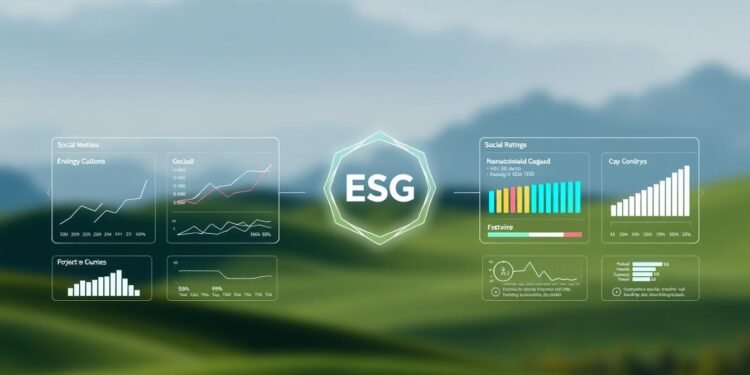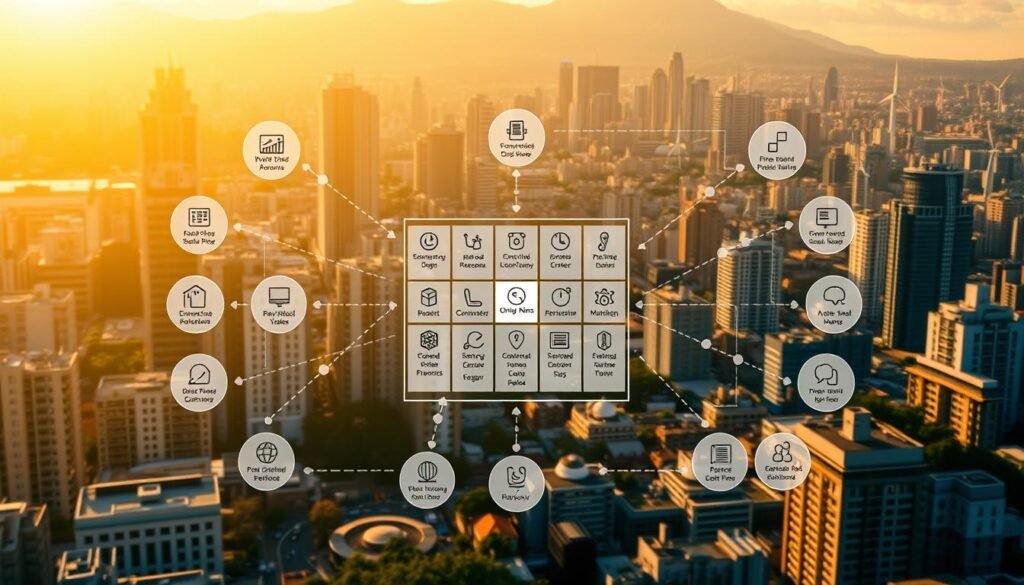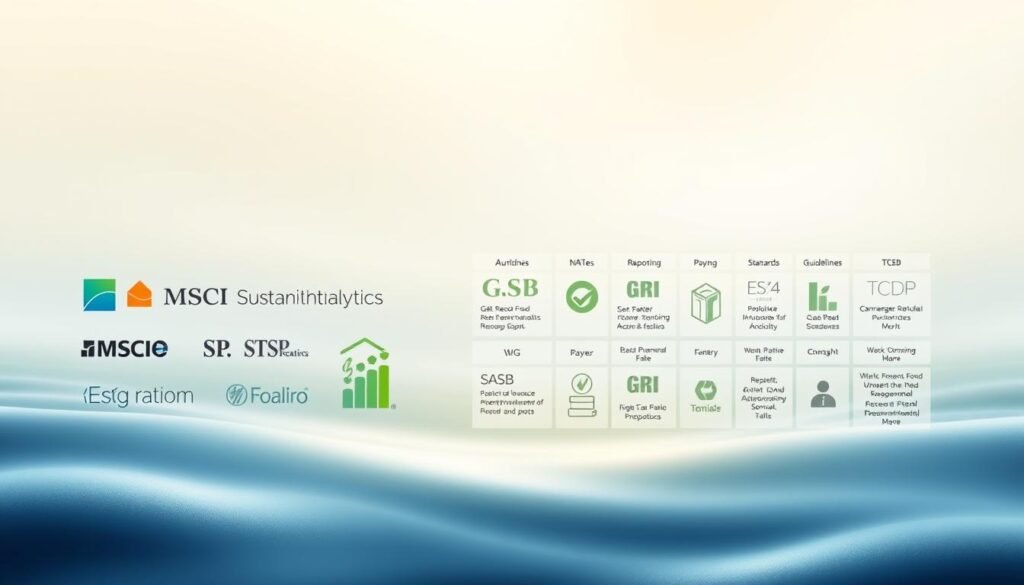What if the most important number for your investment portfolio isn’t the stock price or earnings report? What if there’s a hidden metric that reveals a company’s true long-term potential and risk profile?
This powerful measurement evaluates how businesses operate beyond just profits. It looks at environmental impact, social relationships, and leadership quality. Many forward-thinking investors now consider this crucial for smart decision-making.
Specialized rating agencies analyze publicly available data and company disclosures. They create comprehensive assessments that go beyond traditional financial metrics. These evaluations help stakeholders understand a company’s complete performance picture.
The growing importance of these ratings reflects changing consumer and investor expectations. Companies across various industries now focus on improving their performance in these critical areas. This shift represents a new era in corporate evaluation and risk management.
Key Takeaways
- ESG represents three pillars: Environmental, Social, and Governance factors
- Rating agencies use multiple data sources to calculate these evaluations
- These metrics assess long-term sustainability and risk management capabilities
- Investors increasingly use these assessments in their decision-making process
- Companies across industries are focusing on improving their performance
- These evaluations provide a comprehensive view beyond financial metrics
- Transparency and disclosures play a crucial role in the assessment process
What is an ESG Score?
Modern corporate evaluation extends beyond balance sheets to encompass environmental stewardship, social relationships, and ethical leadership. This comprehensive assessment provides stakeholders with valuable insights into a company’s sustainability practices and long-term viability.
Environmental Component
The environmental dimension examines how businesses interact with our natural world. This includes measuring carbon emissions, energy consumption patterns, and waste management systems.
Companies demonstrate environmental responsibility through resource conservation efforts and pollution reduction strategies. These metrics help assess ecological impact and sustainability commitments.
Social Component
Social evaluation focuses on relationships with employees, customers, and local communities. It covers diversity initiatives, labor practices, and community engagement programs.
This aspect measures how organizations treat their workforce and contribute to societal wellbeing. Customer satisfaction and product safety also factor into social performance assessments.
Governance Component
Governance analysis scrutinizes leadership structures and decision-making processes. It evaluates board diversity, executive compensation models, and shareholder rights protection.
Ethical business practices and transparency mechanisms form the foundation of strong governance. This component ensures accountability and proper oversight throughout the organization.
Different industries may emphasize specific elements based on their operational characteristics. Comprehensive evaluation combines quantitative data with qualitative assessments to create meaningful ratings.
How ESG Scores are Calculated
Understanding the calculation process reveals how these evaluations transform raw data into meaningful insights. Specialized firms gather extensive information from multiple sources to create comprehensive assessments.
This multi-layered approach ensures balanced evaluations that reflect real-world performance. The methodology combines hard numbers with qualitative analysis for complete picture.
Data Collection Methods
Rating agencies employ comprehensive data gathering techniques. They collect company-provided information including sustainability reports and policy documents.
Performance metrics and internal documentation form the foundation of assessment. These materials show how businesses implement their stated commitments.
External sources provide valuable verification and additional context. Regulatory filings, news reports, and NGO assessments offer independent perspectives.
Third-party certifications support evaluation credibility. Standards like ISO 14001 demonstrate environmental management system quality.
Audit reports and industry certifications provide objective validation. This multi-source approach ensures thorough and balanced information gathering.
Rating Agency Methodologies
Assessment firms develop proprietary scoring systems tailored to different industries. They analyze company policies, practices, and actual performance metrics.
The weighting process assigns importance based on industry relevance. Carbon emissions matter more for manufacturing than service companies.
Final evaluations typically use numerical scales or letter-grade ratings. These systems help investors quickly compare organizational performance.
Advanced methodologies blend quantitative data with qualitative assessments. They consider emission metrics alongside policy effectiveness and governance quality.
Rating organizations continually refine their approaches. They adapt to new regulations and evolving stakeholder expectations for improved accuracy.
The Importance of ESG Scores for Investors and Companies
Modern organizations and financial professionals increasingly rely on comprehensive sustainability assessments to guide their strategies. These evaluations provide valuable insights that benefit both investment decisions and corporate operations.
Forward-thinking businesses use these metrics to demonstrate their commitment to responsible practices. Investors leverage this information to build portfolios aligned with their values and risk tolerance.
Informing Investment Decisions
Financial professionals utilize sustainability ratings to identify organizations with strong long-term potential. These assessments help screen out companies with poor environmental or social practices.
Institutional investors incorporate these evaluations into their portfolio construction process. They analyze how businesses manage carbon emissions and community relationships.
Research shows companies with strong sustainability performance often achieve better financial results over time. These organizations typically demonstrate better risk management and operational efficiency.
Enhancing Risk Management
Organizations use sustainability metrics to improve their preparedness for various challenges. These evaluations help identify potential supply chain vulnerabilities and regulatory compliance issues.
Companies focusing on environmental responsibility can better address climate change impacts. Those with strong social practices typically handle labor issues more effectively.
Strong performance in these areas often leads to more favorable financing terms. Lenders view these companies as lower-risk investments with better long-term prospects.
Improving Brand Reputation and Stakeholder Trust
Businesses with excellent sustainability ratings enjoy enhanced brand recognition and customer loyalty. Modern consumers increasingly prefer companies that demonstrate social responsibility.
These organizations attract and retain top talent who value ethical business practices. Employees feel proud working for companies that contribute positively to local communities.
Strong performance builds trust with various stakeholders including partners and regulators. This trust translates into better business relationships and increased market opportunities.
Key Agencies and Frameworks for ESG Scoring
Numerous organizations provide essential frameworks and evaluations that help standardize sustainability assessments. These entities transform complex data into meaningful insights for investors and businesses.
Understanding these key players helps stakeholders navigate the landscape of corporate responsibility evaluations. Different organizations focus on various aspects of sustainability measurement.
Major ESG Rating Agencies
Several prominent firms specialize in evaluating corporate sustainability performance. MSCI and Sustainalytics offer comprehensive assessments across multiple industries.
S&P Global provides detailed analyses that help investors make informed decisions. ISS focuses on governance factors and shareholder rights protection.
The Carbon Disclosure Project (CDP) specializes in environmental impact measurement. They focus particularly on climate change and carbon emissions tracking.
Moody’s integrates sustainability assessments with traditional credit risk analysis. This approach provides a holistic view of company risk profiles.
Global Reporting Initiative (GRI) and Other Standards
The Global Reporting Initiative offers widely adopted sustainability reporting standards. These guidelines help businesses disclose their environmental and social impact.
Principles for Responsible Investment (PRI) provides a framework for investment professionals. It helps integrate sustainability considerations into investment decisions.
The Sustainability Accounting Standards Board (SASB) creates industry-specific reporting standards. These metrics address material sustainability factors relevant to particular sectors.
ISO certifications support corporate sustainability management systems. They provide independent verification of environmental and social responsibility practices.
These frameworks help prevent greenwashing by ensuring consistent reporting methodologies. They create transparency that benefits all stakeholders in the evaluation process.
Challenges and Considerations in ESG Scoring
While sustainability evaluations provide valuable insights, several important factors can affect their accuracy and interpretation. Understanding these limitations helps stakeholders make better-informed decisions.
Different rating organizations may produce varying results for the same business. This variation stems from methodological differences and data interpretation approaches.
Data Consistency and Availability
Information quality varies significantly across organizations and sectors. Some industries have well-established reporting frameworks while others lack standardized metrics.
Private enterprises and emerging market businesses often provide limited disclosures. This creates gaps in the assessment process that can affect evaluation accuracy.
Reporting standards differ globally, making cross-border comparisons challenging. Regional variations in disclosure requirements further complicate consistent measurement.
Greenwashing and Subjectivity
Some organizations may exaggerate their sustainability achievements through selective reporting. This practice, known as greenwashing, can mislead stakeholders about actual performance.
Rating firms employ different weighting systems and evaluation criteria. These methodological differences can lead to divergent assessments of the same company.
Industry trends and peer performance significantly influence relative evaluations. A business might appear strong in one sector but average in another context.
Most assessments measure performance relative to industry peers rather than absolute standards. This makes cross-industry comparisons particularly challenging for investors.
Evaluation methodologies continue evolving as new research emerges. Stakeholders must understand specific rating frameworks to properly interpret results.
These evaluations work best when combined with other analysis tools. They provide important supplementary information rather than standalone decision-making metrics.
Conclusion
Sustainability evaluations mark a fundamental shift in corporate assessment. They measure environmental impact, social relationships, and leadership quality.
These comprehensive metrics help businesses focus on long-term value creation. Companies with strong performance often achieve better financial results over time.
Investors use these assessments to make informed decisions. They identify organizations with better risk management and growth potential.
Transparency and standardized reporting continue to improve evaluation accuracy. This benefits all stakeholders in the decision-making process.
These measurements serve as vital indicators of sustainable business practices. They represent the future of responsible corporate evaluation.
FAQ
What exactly is an ESG score?
An ESG score is a rating that measures a company’s performance and risk exposure across three key areas: environmental impact, social responsibility, and governance practices. It provides a standardized way to assess how a business manages its relationships with the environment, employees, communities, and shareholders.
Who calculates these ratings?
Specialized firms known as rating agencies, such as MSCI, Sustainalytics, and S&P Global, calculate these ratings. They use proprietary methodologies to analyze publicly available data, company disclosures, and industry research to produce a consistent evaluation.
Why are these ratings important for investors?
These ratings help investors identify companies with strong management of long-term risks and opportunities. They provide crucial insights beyond traditional financial metrics, informing decisions that can lead to more sustainable and potentially more stable returns.
Can a company improve its rating?
Yes, companies can improve their ratings by enhancing disclosures, implementing stronger policies, and demonstrating tangible progress in areas like carbon emissions reduction, diversity, and board accountability. Transparency and consistent reporting are key.
What is the biggest challenge with these scores?
A significant challenge is the lack of standardization. Different agencies use varying methodologies and weightings, which can lead to inconsistent ratings for the same company. This makes direct comparisons difficult and highlights issues with data consistency.
How does the Global Reporting Initiative (GRI) fit in?
The Global Reporting Initiative provides a widely used framework for sustainability reporting. Many companies use GRI standards to structure their disclosures, which in turn supply the data that rating agencies use to calculate their scores.







